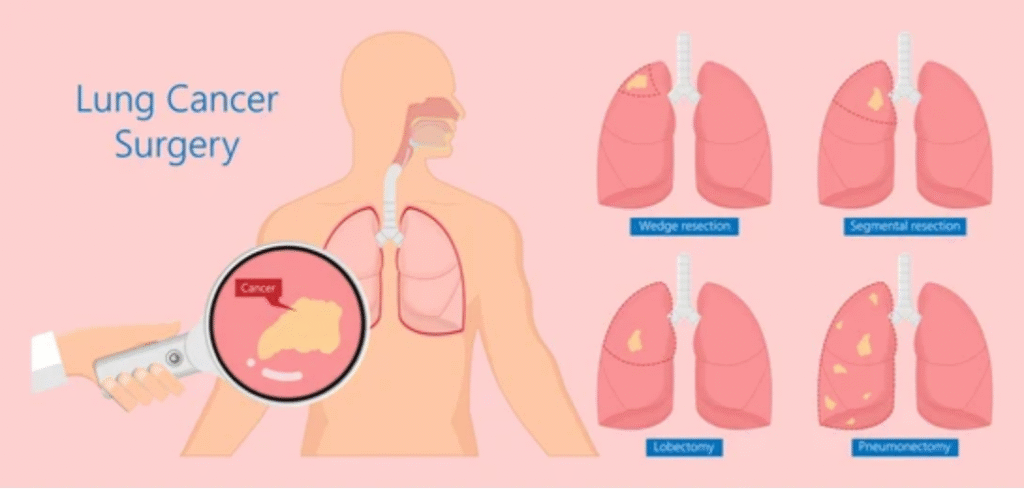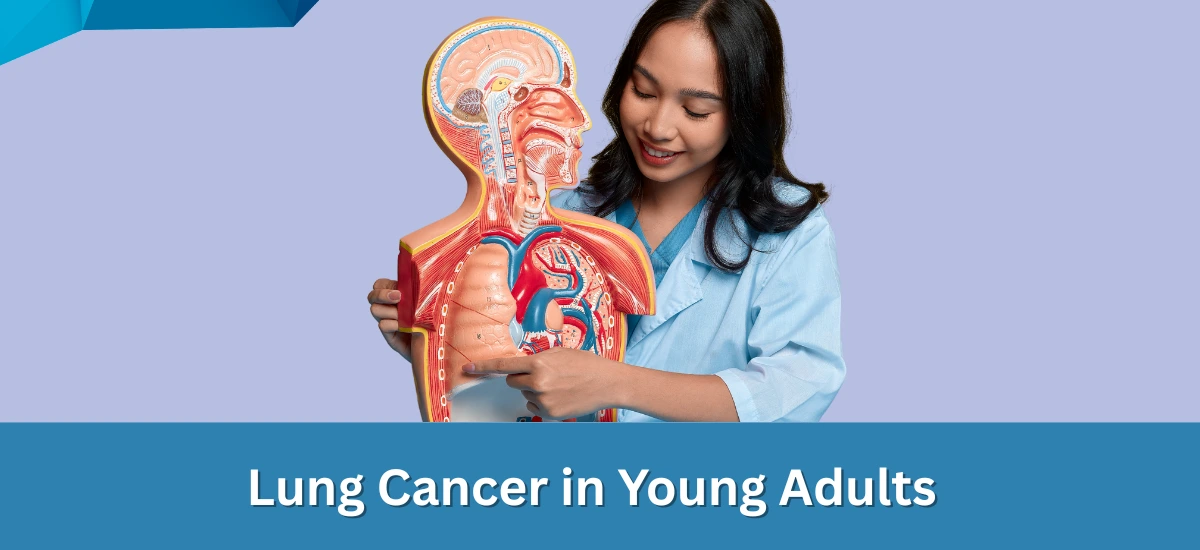- Have any questions?
- 085913 90567
- drgeorgechestdiseases@gmail.com
Lung Cancer in Young Adults: Causes, Symptoms, and Hope for the Future

Tracheal Cancer vs. Throat Cancer
June 12, 2025
Is lung cancer hereditary?
July 15, 2025H1: Lung Cancer in Young Adults: Causes, Symptoms, and Hope for the Future

Lung cancer, traditionally associated with older adults and smokers, is increasingly being diagnosed in young adults, including non-smokers. In India, the incidence of lung cancer has risen from 6.62 per 100,000 in 1990 to 7.7 per 100,000 in 2019, with a significant rise expected in urban areas by 2025. Globally, lung cancer remains one of the most commonly diagnosed cancers, with 2.2 million cases reported in 2020.
Dr. George Karimundackal, a distinguished thoracic surgeon in Mumbai, states, “The increasing incidence of lung cancer in young adults, especially non-smokers, is alarming. Early detection and awareness are crucial in improving outcomes.”
With over 15 years of experience, Dr. Karimundackal specializes in thoracic surgeries, including minimally invasive procedures for lung cancer. His expertise in treating lung cancer in young adults has been instrumental in advancing treatment protocols and increasing patient survival rates.
Let’s delve into the reasons that are putting more young adults at risk of lung cancer.
Why Is Lung Cancer Rising in Young Adults?

The increasing incidence of lung cancer in young adults, particularly non-smokers, is attributed to several factors:
- Environmental Pollution:
Exposure to increasing levels of air pollution, especially in urban areas, is a major risk factor.
- Genetic Predisposition:
EGFR and ALK mutations are widely observed in young, non-smoking lung cancer patients.
- Passive Smoking:
Secondhand smoke exposure from domestic or public places has a significant risk factor.
- Radon and Toxic Exposure:
Inhalation of work-place or home-exposure to radon gas, asbestos, and industrial chemicals can trigger lung cancer in adults.
- Delayed Symptom Recognition:
Misinterpreted or neglected symptoms among young people result in delayed diagnoses.
- Lack of Routine Screening:
Routine lung cancer screenings focus on elderly populations, failing to identify early symptoms in young populations.
- Lifestyle Factors:
Unhealthy eating habits, no exercise, and compromised immunity also make one susceptible to overall cancers.
Let’s look at the typical early signs of lung cancer in youth that are easily dismissed.
Common Symptoms Often Ignored in Youth
Young adults might overlook early signs of lung cancer and dismiss them as signs of milder conditions. Some key signs include:
- Recurring cough worsening with time
- Coughing up rust-colored sputum or blood
- Chest pain over deep breathing or cough
- Shortness of breath while performing regular physical activities
- Unintended weight loss and fatigue
- Recurrent respiratory infections
- Hoarseness or wheezing
- Swelling of the face or neck
Why is lung cancer so often missed in younger people? Let’s discuss the diagnostic roadblocks that delay life-saving treatment in youth.
Diagnostic Challenges in Young Patients

Young adult lung cancer tends to occur atypically, causing delay or misdiagnosis. Young patients, particularly non-smokers, are not generally regarded as high-risk by default, unlike older ones with obvious risk factors such as heavy smoking. The low clinical suspicion accordingly tends to dismiss symptoms of chronic cough, fatigue, or mild chest pain as minor respiratory infections, allergies, or even stress.
Adding to the challenges is the fact that there is no uniform screening protocol for lung cancer in young adults. Screening programs target older smokers, and younger individuals go undiagnosed until their cancer is advanced. Even when imaging tests are conducted, small nodules do not necessarily trigger immediate suspicions. In some cases, lung cancer diagnosis in young adults comes only after symptoms become worsening or persist significantly.
The unawareness of both the patients and the general practitioners is also a cause of diagnostic delays. Early detection drives and education are thus essential—more so in urban areas such as Mumbai, where pollution and lifestyle issues double the risk.
Don’t let symptoms slip under the radar. A thorough check-up from a competent professional can make all the difference.
Treatment Options for Young Adults with Lung Cancer
Treatment strategies for young adults with lung cancer are tailored based on the cancer type, stage, and genetic profile.
- Surgery:

Often the first line of treatment for early-stage cancer, surgery involves removing the tumor and, in some cases, part of the lung. Minimally invasive techniques, such as VATS (Video-Assisted Thoracoscopic Surgery), help reduce recovery time and improve patient outcomes.
- Radiation Therapy:
High-energy beams kill cancer cells, particularly if surgery cannot be done. It is usually paired with other treatments to achieve improved results.
- Chemotherapy:
Drugs are administered to eliminate or reduce cancer cells. It’s usually applied to advanced phases or along with surgery and radiation to increase efficacy.
- Targeted Therapy:
Designed for patients with specific genetic mutations (like EGFR or ALK), these drugs block the growth of cancer cells while sparing healthy cells, offering fewer side effects.
- Immunotherapy:
Boosts the body’s immune system to recognize and destroy cancer cells. It’s especially promising for non-small cell lung cancer and is tailored based on the patient’s biomarkers.
- Clinical Trials:
Young adults might qualify for trials that provide access to innovative treatments not yet in common use, which can be of great benefit in treating unusual or resistant cases.
Life After Diagnosis: Hope, Support, and Survivorship

Receiving a lung cancer diagnosis as a young adult can be emotionally overwhelming, but it’s essential to know that many go on to live meaningful, fulfilling lives. With advanced treatments and supportive care, long-term survival and even remission are now realistic outcomes.
Beyond treatment, survivorship involves ongoing support—both physical and emotional. Rehabilitation programs help individuals regain strength and improve lung function, while support groups offer a sense of community and shared experiences. Psychological counseling may even alleviate anxiety, depression, and fear of recurrence.
Follow-ups and lifestyle changes become routine. With proper medical advice and a good support system, young survivors can concentrate on recovery, career, relationships, and personal development—showing that indeed there is life after lung cancer.
Want to know how to protect yourself from lung cancer early on? Let’s dive into practical, life-saving tips every young adult should know.
Lung Cancer Prevention Tips for Young Adults
While not all cases are preventable, certain measures can reduce the risk of developing lung cancer:
- Avoid Tobacco: Stop smoking and do not expose yourself to secondhand smoke.
- Test for Radon: Ensure your home is tested for radon gas, a known carcinogen.
- Protect Against Occupational Hazards: Use protective equipment if exposed to harmful substances like asbestos or diesel exhaust.
- Monitor Air: Use air purifiers and stay away from highly polluted areas.
- Healthy Lifestyle: Regular exercise and a fruit- and vegetable-filled diet.
- Regular Check-ups: Routine health checks and consultations with your physician regarding any recurring symptoms.
Conclusion
Young-adult lung cancer is a developing issue, often manifesting in the absence of classic risk factors such as smoking. Symptom awareness, early detection, and the availability of expert care are critical.
With proper medical care and knowledge, young patients can look beyond the diagnosis towards recovery and a healthy life—particularly when in the hands of an expert such as Dr. George Karimundackal, who knows the special needs of younger patients.
Awareness is the first step toward prevention. Reach out to a seasoned specialist today for expert guidance.
Frequently Asked Questions
1. Can young adults really get lung cancer?
Yes, lung cancer can affect individuals of any age, including young adults, regardless of smoking history.
2. What are the causes of lung cancer in young people?
Factors include genetic mutations (e.g., EGFR, ALK) and environmental exposures, such as air pollution, radon gas, and secondhand smoke.
3. Is lung cancer more aggressive in younger patients?
Young adult lung cancer may be aggressive and diagnosed late, making early detection a priority.
4. What should I do if I have a persistent cough or chest pain?
Consult a healthcare provider promptly for evaluation, especially if symptoms persist beyond a few weeks.
5. Are there targeted therapies available for young patients?
Yes, targeted therapies are available for specific genetic mutations common in young non-smokers with lung cancer.
6. How can young people reduce their risk of lung cancer?
Avoid tobacco, minimize exposure to environmental pollutants, maintain a healthy lifestyle, and seek regular medical check-ups.
Reference links:
https://www.verywellhealth.com/lung-cancer-in-young-adults-2248879
https://utswmed.org/medblog/lung-cancer-young-nonsmokers
Disclaimer: The content shared on this page is for informational purposes and not for promotional use.

